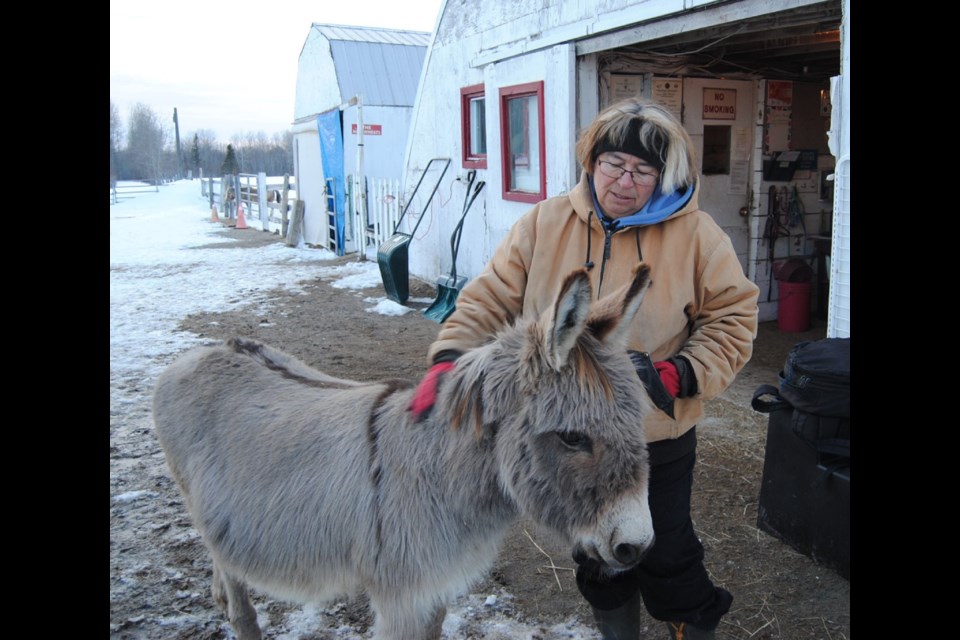TIMMINS — There is a horse ranch northwest of Timmins off of Kamiskotia Road that is a healing spot for many residents suffering from either a physical, emotional or mental affliction.
The ranch is operated by the Timmins Therapeutic Riding Association (TTRA) established by Lydia Dubanow and her husband Paul Dubanow in 1984 and were incorporated in 1987.
“I have been riding horses all my life,” Lydia Dubanow said. “I am a riding coach since 1973.”
Lydia first got the idea for a therapeutic horse ranch in the 1970s.
“I had a student with special needs and I had to find a way to meet those needs,” Dubanow explained. “I researched how to do this and discovered ways to include people with special needs with horse riding.”
The TTRA is currently training volunteers to help with their special needs riding program that gets under way after Victoria Day.
Since Tuesday April 5, Dubanow and her staff have been training the volunteers to care for the horses.
The training has been running every Tuesday since April 5th and concludes next Tuesday April 26th. During that time the volunteers learned grooming, tracking, side walking and leading and mounting.
What is it about horses that help people with special needs and disabilities?
The people who sign up for our programs have emotional or developmental issues, learning disabilities, autism,” informed Dubanow. “Or the have suffered physical ailments or conditions such as a stroke, cancer, suffered heart attacks.
That list also includes people who have been abused and suffer from post traumatic stress disorder.
What is it about horses that makes them such good therapy animals?
“It is the bond that develops between people who have been dealing with mental, emotional and physical distress and horses that makes this so therapeutic,” Dubanow explained.
“Horses are non judgemental and they deal with body language, that is how they deal with the herd members; they are not aggressive with their body language,” Dubanow said.
“If a person has low self-esteem – to be able to control and manage a horse, such a large animal, increases their self esteem," said Dubanow.
“They are very gentle and soft animals,” she added. “Everyone loves horses.”
“When people with disabilities or health issues are dealing with horses- the horses seem to sense when someone has a problem,” Dubanow surmised.
In explaining why there are so many dogs running around the ranch. Dubanow said the dogs and the donkeys are there to protect the horses. The dogs make sure predators don’t disturb the horses. The donkeys and horses develop a deep affection for each other. The horse helps groom and nurture the donkey and the donkeys are their guardians.
Goats have also been used on some horse farms. Let’s just call it therapy for the therapy horses,
The horses on Dubanow’s ranch come in different sizes and temperaments.
“These guys are smaller,” points out Dubanow, “These guys have pulling a cart ability and can be used for people who can’t get astride a horse but can get onto a cart and drive.”
Dubanow would like to make the TTRA programs available all year round to her clients, but the ranch doesn’t have an indoor riding forum.
The TTRA is funded through social organizations and individuals who pay for their clients to enlist for TTRA programs. It’s a registered charity can give tax deduction.
The volunteers get a chance to be with horses and they also are able to enhance their skills as personal support workers for example. The TTRA enlists between 25 to 30 volunteers.
“We do get a summer student funded by the province’s summer employment program,” acknowledged Dubanow. “And we have our charity bingo twice a month.”
TTR also has corporate sponsors and receives in memoriam donations.
It costs about $100,000 a year to run the ranch. The riding trail is about 4 km around.
Dubanow keeps her horses outside year round with plenty of shelter available for the horses should they need it.
“Horses move 30 km a day looking for food,” Dubanow said. “They are constantly digesting and they need to run free to properly digest.”
That explains why horses in tightly packed stalls or paddocks of race track often are in bad temper and kick and buck, she said.
Click here to access the TTRA website www.ttra.ca
